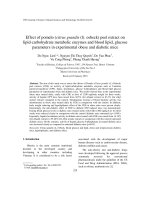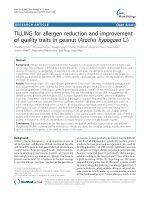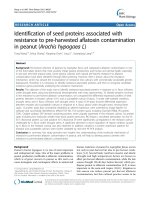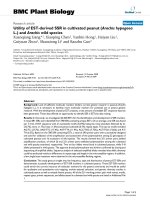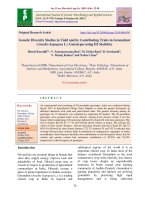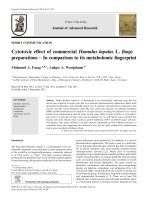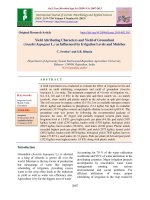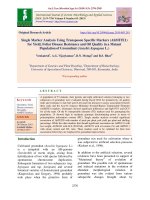Effect of organic and inorganic sources of nutrients on yield attributes and yield of groundnut (Arachis hypogaea L.)
Bạn đang xem bản rút gọn của tài liệu. Xem và tải ngay bản đầy đủ của tài liệu tại đây (248.23 KB, 8 trang )
Int.J.Curr.Microbiol.App.Sci (2020) 9(5): 2893-2900
International Journal of Current Microbiology and Applied Sciences
ISSN: 2319-7706 Volume 9 Number 5 (2020)
Journal homepage:
Original Research Article
/>
Effect of Organic and Inorganic Sources of Nutrients on Yield Attributes
and Yield of Groundnut (Arachis hypogaea L.)
P. Murugan*, P. Kumaravel and N. Akila
Krishi Vigyan Kendra, Tamil Nadu Veterinary and Animal Sciences University
Namakkal – 637002, Tamil Nadu, India
*Corresponding author
ABSTRACT
Keywords
Composted poultry
manure, Fish pod
silt, Groundnut,
vermicompost,
Yield
Article Info
Accepted:
23 April 2020
Available Online:
10 May 2020
Field experiments were carried out to study the effect of different sources of organic
manures and inorganic fertilizers on yield attributes and yield of groundnut at Krishi
Vigyan Kendra, Tamil Nadu Veterinary and Animal Sciences University, Kattupakkam
during Rabi 2014 and 2015. The experiments were laid out in split-plot design consisting
of twelve treatments with 3 replications. The main plot consisted of Farm yard manure @
12.5 t ha-1 (M1), Vermicompost @ 5.0 t ha-1 (M2), Fish pond silt @ 5.0 t ha-1 (M3) and
Composted poultry manure @ 5.0 t ha-1 (M4) and sub plot consisted of 100 per cent
recommended dose of fertilizers NPK (S1), 75 per cent recommended dose of NPK (S2)
and 50 per cent of recommended dose of NPK (S3). Data on yield parameters viz., Number
of pods plant-1, Number of kernels pod-1, 100 kernel weight (g), pod yield and haulm yield
of groundnut (kg ha-1) were collected for different treatments. Results revealed that
application of vermicompost @ 5.0 t ha-1 (M2) recorded significantly higher number of
pods plant-1 (24 and 25 nos.), higher groundnut pod yield (2488 and 2549 kg ha -1) and
higher haulm yield (4170 and 4279 kg ha -1) as compared to other organic manure
treatment in both the season. Similar trend was observed in the case of number of kernel
pod-1 also, whereas, the 100 kernel weight was not significant due to the application of
different organic manure. In addition, application of recommended dose of 100 per cent
NPK (S1) significantly recorded higher number of pods plant -1 (22.9 and 24 nos.), higher
groundnut pod yield (2436 and 2490 kg ha -1) and higher haulm yield (4092 and 4190 kg
ha-1) over 75 and 50 per cent of NPK levels in both the years. However, the interaction
between organic manures and fertilizer levels were not significant on number of kernel
pod-1, 100 kernel weight, pod yield and haulm yield of groundnut but highly significant on
number of pods plant-1. The study showed that groundnut crop responded well in terms of
yield attributes, pod yield and haulm yield by the application of vermicompost @ 5.0 t ha-1
and 75 per cent recommended dose of NPK fertilizers.
Introduction
Groundnut (Arachis hypogaea L.) is a unique
and important oilseed crop of Tamil Nadu. In
Tamil Nadu, groundnut is cultivated in 3.39
lakh ha with a production of 7.85 lakh tonnes
and productivity of 2751 kg ha-1 (2012-13).
The groundnut kernel is used mainly for
2893
Int.J.Curr.Microbiol.App.Sci (2020) 9(5): 2893-2900
edible oil and contains nearly half of the
essential vitamins and one-third of the
essential minerals. Hence, groundnut played
an important role in nutritional security to the
resource poor farmers. In addition, the haulms
provided excellent fodder for livestock, cake
obtained after oil extraction was used in
animal feed and overall the crop acted as
good source of biological nitrogen fixation
(Nautiyal et al., 2011). In recent years, crop
cultivation requires the use of chemical
fertilizer, but it is expensive for people who
have not capacity to buy fertilizer. Therefore,
the current trend is to explore the possibilities
of supplementing organic manures like farm
yard manure, vermicompost, poultry manure
etc. Indigenously available organic sources of
nutrients have enhanced the efficiency and
reduced the requirements of chemical
fertilizers (Bhat et al., 2007). Hence, it is
necessary to integrate different sources of
nutrients to meet the crop requirement. Such
integrated approach with special emphasis on
combined application of inorganic fertilizers
with organic manures would sound well in
oilseed crops like groundnut grown under
aberrated climatic conditions. Therefore, an
experiment was conducted to study the effect
of integrated use of organic and inorganic
sources of nutrients on yield of groundnut in
Kancheepuram district of Tamil Nadu.
Materials and Methods
Field experiments were carried out to study
the effect of different sources of organic and
inorganic nutrients on yield attributed and
yield of groundnut at Krishi Vigyan Kendra,
Tamil Nadu Veterinary and Animal Sciences
University, Kattupakkam located at North
Eastern zone of Tamil Nadu at lies between
11° 00' to 12° 00' North latitudes and 77° 28'
to 78° 50' East longitudes during Rabi 2014
and 2015. The soil of the experimental site
was moderately well drained, sandy clay loam
in texture and chemical analysis showed low
in available nitrogen (199.5 kg ha-1), medium
in available phosphorus (19.8 kg ha-1) and
high in available potassium (461.3 kg ha-1),
0.55 per cent of organic carbon and 7.8 pH of
the soil. The experiments were laid out in
split-plot design consisting of twelve
treatments (four main and three sub plots)
with 3 replications. The main plot consisted
of Farm yard manure @ 12.5 t ha-1(M1),
Vermicompost @ 5.0 t ha-1 (M2), Fish pond
silt @ 5.0 t ha-1 (M3) and Composted poultry
manure @ 5.0 t ha-1 (M4) and sub plot
consisted of 100 per cent (25:50:75 kg NPK
ha-1) recommended dose of fertilizers (S1), 75
per cent recommended dose of fertilizers (S2)
and 50 per cent of recommended dose of
fertilizers (S3).
The groundnut variety TMV-13 was used for
treatment. Beds and channel were formed,
layout was taken and organic manures were
applied to each plot in accordance with the
treatments assigned, incorporated manually
and levelled. The seeds were sown in a plot
size of 6.0 m x 5.0 m spaced with 30 x 10 cm
for each treatment during Rabi 2014 and
2015. Full dose of phosphorus and potassium
along with half dose of nitrogen in all the
treatments was applied as basal. Remaining
dose of nitrogen was applied at 30 days after
sowing at the time of weeding as per the
treatments. All other recommended cultural
practices and prophylactic plant protection
measures were followed to raise healthy crop.
Observations were recorded in 10 randomly
taken and tagged plants from each replication
on Number of pods plant-1, Number of kernels
pod-1, 100 kernel weight (g), pod yield and
haulm yield of groundnut (kg ha-1) of
different treatments. The harvested pods yield
from each net plot cleaned separately as per
the moisture content and expressed in kg ha-1.
The haulm yield of groundnut was recorded
from the net plot area after enough sun drying
and expressed in kg ha-1. The data on various
parameters were statistically analyzed in split
2894
Int.J.Curr.Microbiol.App.Sci (2020) 9(5): 2893-2900
plot design as suggested by Gomez and
Gomez (2010). Wherever the treatment
difference was significant, critical differences
were worked out at five per cent probability
level.
Results and Discussion
Yield attributes of groundnut
The number of pods plant-1 and number of
kernel pod-1 were positively influenced by the
application of organic manures and different
levels
of
NPK
fertilizer,
whereas
100 kernel weight of groundnut was not
significantly influenced by the application of
organic manures and different levels of NPK
fertilizer during Rabi 2014 and 2015 (Table 1
and 2).
Among different organic manure application,
vermicompost
application
@
5.0 t ha-1 (M2) significantly recorded higher
number of pods plant-1 (24 and 25 nos.) in
both the years. The composted poultry
manure application @ 5.0 t ha-1 (M4) was the
next best treatment followed by the
application of FYM @ 12.5 t ha-1 (M1) during
both the years. Similar trend was observed in
the case of number of kernel pod-1 also,
whereas, the 100 kernel weight was not
significant due to the application of different
organic manure. With regard to different NPK
fertilizer levels tried, higher number of pods
plant-1 (22.9 and 24 nos.) was observed with
the application of 100 per cent recommended
dose of NPK fertilizers (S1). It was followed
by the application of 75 per cent
recommended dose of NPK fertilizers (S2).
These two were comparable with each other.
Application of 50 per cent recommended dose
of NPK fertilizers (S3) registered lowest
number of pods plant-1. Similar trend was
observed for number of kernel pod-1 also.
Different levels of recommended dose of
NPK fertilizers did not show any significant
improvement on the 100 kernel weight during
both the years.
Interaction effect between organic manures
and NPK fertilizers levels was highly
significant on number of pods plant-1 in both
the years. Combined application of
vermicompost @ 5.0 t ha-1 along with 75 per
cent of recommended dose of NPK (M2 S2)
registered higher number of pods plant-1 (26.3
and 27.4 nos) in both the years. It was on par
with application of vermicompost along with
100 per cent of recommended dose of NPK
fertilizers (M2 S1) in both the years. The
interaction effect on number of kernel pod-1
and 100 kernel weight of groundnut was not
at all significant in both the years.
Pod yield of groundnut
Groundnut pod yield was significantly
influenced due to the application of organic
manures and different levels of NPK
fertilizers during both the years. Among
organic manures application, vermicompost
application @ 5.0 t ha-1 (M2) recorded
significantly higher groundnut pod yield of
2488 and 2549 kg ha-1 during Rabi 2014 and
2015, respectively. It was followed by the
application of composted poultry manure
treatment @ 5.0 t ha-1 (M4), which recorded
on yield of 2379 and 2417 kg ha-1. The lowest
groundnut pod yield of 2344 and 2391 kg ha-1
was observed with fish pond silt @ 5.0 t ha-1
(M3) during Rabi 2014 and 2015, respectively
(Table 3 and 4).
Regarding fertilizer levels, application of
recommended dose of 100 per cent NPK
fertilizers (S1) significantly recorded higher
groundnut pod yield of 2436 and 2490 kg ha-1
during Rabi 2014 and 2015, respectively. It
was on par with the application of 75 per cent
of NPK fertilizers (S2), which recorded on
yield of 2421 and 2463 kg ha-1 during Rabi
2014 and 2015, respectively.
2895
Int.J.Curr.Microbiol.App.Sci (2020) 9(5): 2893-2900
Table.1 Effect of treatments on yield attributes of groundnut during Rabi 2014
Number of pods plant-1
Treatments
Number of kernel pod-1
100 kernel weight (g)
S1
S2
S3
Mean
S1
S2
S3
Mean
S1
S2
S3
Mean
M1
22.0
21.2
19.4
20.8
1.61
1.60
1.50
1.57
44.1
44.0
44.0
44.0
M2
23.6
26.3
22.4
24.0
1.64
1.69
1.62
1.64
44.2
44.6
44.2
44.3
M3
22.2
20.6
19.2
20.6
1.54
1.52
1.50
1.52
43.9
43.8
43.7
43.8
M4
24.2
23.1
21.0
22.7
1.60
1.60
1.58
1.59
44.0
43.8
43.8
43.8
Mean
22.9
22.8
20.5
1.59
1.60
1.55
44.0
44.0
43.9
Number of pods plant-1
Number of kernel pod-1
100 kernel weight (g)
M
S
M at S
S at M
M
S
M at S
S at M
M
S
M at S
S at M
SEd
0.1
0.2
0.3
0.4
0.01
0.01
0.03
0.03
0.5
0.3
0.8
0.7
CD(P=0.05)
0.2
0.4
0.7
0.8
0.03
0.03
NS
NS
NS
NS
NS
NS
Main Plot
M1 - FYM @12.5 t ha-1
M2 - Vermicompost @ 5.0 t ha-1
M3 - Fish pond silt @ 5.0 t ha-1
M4 - Composted poultry manure @ 5.0 t ha-1
Sub plot
S1 - 100 per cent recommended NPK
S2 - 75 per cent recommended NPK
S3 - 50 per cent recommended NPK
2896
Int.J.Curr.Microbiol.App.Sci (2020) 9(5): 2893-2900
Table.2 Effect of treatments on yield attributes of groundnut nut during Rabi 2015
Number of pods plant-1
Treatments
Number of kernel pod-1
100 kernel weight (g)
S1
S2
S3
Mean
S1
S2
S3
Mean
S1
S2
S3
Mean
M1
23.2
22.5
20.2
21.9
1.62
1.56
1.50
1.56
44.2
44.1
44.0
44.1
M2
24.2
27.4
23.5
25.0
1.61
1.68
1.60
1.63
44.2
44.6
44.2
44.3
M3
23.1
21.7
20.1
21.6
1.55
1.50
1.50
1.51
44.0
43.9
43.9
43.9
M4
25.6
24.8
22.2
24.2
1.61
1.60
1.58
1.59
44.2
44.0
44.0
44.0
Mean
24.0
24.1
21.4
1.59
1.58
1.54
44.1
44.1
44.0
Number of pods plant-1
Number of kernel pod-1
100 kernel weight (g)
M
S
M at S
S at M
M
S
M at S
S at M
M
S
M at S
S at M
SEd
0.3
0.2
0.4
0.4
0.01
0.02
0.03
0.04
0.7
0.3
0.9
0.7
CD(P=0.05)
0.8
0.4
1.1
0.9
0.04
0.04
NS
NS
NS
NS
NS
NS
Main Plot
M1 - FYM @12.5 t ha-1
M2 - Vermicompost @ 5.0 t ha-1
M3 - Fish pond silt @ 5.0 t ha-1
M4 - Composted poultry manure @ 5.0 t ha-1
Sub plot
S1 - 100 per cent recommended NPK
S2 - 75 per cent recommended NPK
S3 - 50 per cent recommended NPK
2897
Int.J.Curr.Microbiol.App.Sci (2020) 9(5): 2893-2900
Table.3 Effect of treatments on pod and haulm yield of groundnut during Rabi 2014
Pod yield (kg ha-1)
Treatments
Haulm yield (kg ha-1)
S1
S2
S3
Mean
S1
S2
S3
Mean
M1
2411
2368
2306
2362
4096
3915
3825
3945
M2
2476
2595
2392
2488
4152
4350
4007
4170
M3
2405
2340
2286
2344
3984
3923
3813
3907
M4
2451
2381
2306
2379
4136
3946
3905
3996
Mean
2436
2421
2323
4092
4033
3887
Pod yield (kg ha-1)
Haulm yield (kg ha-1)
M
S
M at S
S at M
M
S
M at S
S at M
SEd
40
22
54
43
85
44
112
89
CD(P=0.05)
99
46
NS
NS
NS
94
NS
NS
Table.4 Effect of treatments on pod and haulm yield of groundnut during Rabi 2015
Pod yield (kg ha-1)
Treatments
Haulm yield (kg ha-1)
S1
S2
S3
Mean
S1
S2
S3
Mean
M1
2460
2405
2361
2409
4157
4126
3910
4064
M2
2565
2644
2439
2549
4251
4468
4117
4279
M3
2451
2385
2337
2391
4098
4012
3922
4011
M4
2486
2419
2345
2417
4253
4026
3998
4092
Mean
2490
2463
2370
4190
4158
3987
Pod yield (kg ha-1)
Haulm yield (kg ha-1)
M
S
M at S
S at M
M
S
M at S
S at M
SEd
21
22
42
44
33
51
90
102
CD(P=0.05)
52
47
NS
NS
81
108
NS
NS
2898
Int.J.Curr.Microbiol.App.Sci (2020) 9(5): 2893-2900
Application of 50% recommended dose of
NPK fertilizers recorded the lowest groundnut
pod yield of 2323 and 2370 kg ha-1 in both the
years. The interaction effect between organic
manures and NPK fertilizer levels was nonsignificant on groundnut pod yield in both the
years.
Haulm yield of Groundnut
Groundnut haulm yield was significantly
influenced by the application of organic
manures and different levels of NPK
fertilizers in the both the years (Table 3 and
4). Application of vermicompost @ 5.0 t ha1
(M2) recorded significantly higher groundnut
haulm yield of 4170 and 4279 kg ha-1 in
during Rabi 2014 and 2015, respectively. It
was followed by the application of composted
poultry manure @ 5.0 t ha-1 (3996 and 4092
kg ha-1). The fish pond silt (M3) recorded
conspicuously the lowest groundnut haulm
yield. Among the different fertilizer levels
tried, application of 100 per cent
recommended dose of NPK fertilizers (S1)
recorded significantly higher groundnut
haulm yield of 4092 and 4190 kg ha-1 during
Rabi 2014 and 2015, respectively. It was on
par with the application of 75% recommended
dose of NPK fertilizers (S2) in both the years.
The lowest groundnut haulm yield was
observed with the application of 50 per cent
recommended dose of NPK fertilizers (S3).
Interaction effect between organic manures
and fertilizer levels did not exhibit any
significant variations on the haulm yield of
groundnut in both the years.
Number of groundnut pods plant-1, pod yield
and haulm yield was positively influenced by
the application of organic manures and
different levels of NPK fertilizer during both
the years. Combined application of
vermicompost and 75 per cent of
recommended dose of fertilizers recorded
significantly higher yield compared to lower
level of NPK fertilizers. The yield
improvement could be attributed to
continuous availability of nutrients, growth
promoting effect of vermicompost and
ultimately leads
more
photosynthetic
activities, cell division and cell elongation,
enhanced carbohydrate as well as metabolic
process and improvement of soil structure by
increasing the soil water holding capacity,
good aeration, which encourages better root
growth and nutrient uptake. These results
were corroborated with the findings of
Ramasamy and Umapathi, (2010). The
beneficial effect of vermicompost on yield
and yield attributes might be attributed to its
ability of sustain availability of nutrients
throughout the growing season. The increased
balanced C:N ratio might have increased the
synthesis of carbohydrates with ultimate
improvement in yield and yield attributes.
These findings corroborate with those of
Mathivanan et al., (2012), Kondappa et al.,
(2009) and Yadav and Yadav (2010).
Poultry manure is excellent organic manure,
since it contains high amount of nitrogen,
phosphorus, potassium and other essential
nutrients. Poultry manure improves the
number of pods per plant, pod yield and
haulm yield in groundnut as reported by
Subrahmaniyan et al., (1999). Groundnut
being a leguminous crop, capable of fixing
atmospheric nitrogen and application of
fertilizers including gypsum with organic
manures enhanced the productivity of
groundnut. Veeramani et al., (2012) observed
similar findings.
In agricultural land soil fertility depletion is
an important draw back due to continuous
cultivation with inorganic nutrients. In order
to increase the soil fertility, inorganic
fertilizers are being widely utilized in
cultivable lands. Even though they promote
the growth of crops, their toxic effect is the
negative impact by means of their over
2899
Int.J.Curr.Microbiol.App.Sci (2020) 9(5): 2893-2900
utilization of fertilizers. To overcome these
factors, the combined application of organic
manure especially vermicompost, poultry
manures and farm yard manure along with
NPK fertilizers is recommended. The study
showed that the yield attributes, pod yield and
haulm yield parameters of groundnut were
enhanced by different sources of organic
manures and levels of NPK fertilizers. Among
the organic manure treatments, application of
vermicompost performed better than the other
sources through improved number of pods
plant-1, number of kernel pod-1, pod yield and
haulm yield of groundnut crop. It could be
concluded that the groundnut crop responded
well in terms of yield attributes, pod yield and
haulm yield by the application of
vermicompost @ 5.0 t ha-1 and 75%
recommended dose of NPK fertilizers.
References
Bhat, M.A., Singh, R and Kohli, A. 2007.
Effect of integrated use of farm yard
manure and fertilizer nitrogen with and
without sulphur on yield and quality of
Indian mustard. Journal of the Indian
Society of Soil Science. 55 (2): 224226.
Gomez, K.A. and A.A. Gomez. 2010.
Statistical procedures for Agricultural
Research (4th ed). Wiley India Pvt. Ltd.,
New Delhi, India.
Kondappa, D., B.M. Radder, P.L. Patil, N.S.
Hebsur and S.C. Alagundagi. 2009.
Effect
of
integrated
nutrient
management on growth, yield and
economics of chilli in a vertisol.
Karnataka Journal of Agricultural
Sciences. 22: 438-440.
Mathivanan, S., A. Chidambaram, P.
Sundaramoorthy and R. Bakiyaraj.
2012. Effect of vermicompost on
growth and yield of groundnut.
International Journal of Environmental
Biology. 2 (1): 7 -11.
Nautiyal, P.C., Ravindra, V., Rathnakumar,
A.L., Ajay, B.C., and Zala, P.V. 2011.
Genetic variations in photosynthetic
rate, pod yield and yield components in
Spanish groundnut cultivars during
three cropping seasons. Field Crops
Research. 125: 83–91.
Ramasamy, P.K. and S. Umapathi. 2010.
Efficacy of vermicompost on the head
yield status of the sunflower plant
(Helianthu annuus L.). Pollution
Research. 29 (3):417-420.
Subrahmaniyan K. N., P. Arulmozhi and
Kalaiselvan. 1999. Effect of irrigation
layout, irrigation and fertilizer levels on
the yield of rainfed groundnut. Crop
Research. 18: 19-21.
Veeramani, P., K. Subrahmaniyan and V.
Ganesaraja. 2012. Organic manure
management on groundnut. Wudpecker
Journal of Agricultural Research. 1(7):
238 – 243.
Yadav, S.S. and N. Yadav. 2010. Effect of
integrated nutrient management on yield
of okra in zaid crop. Bhartiya Krishi
Anusandhan Patrika, 25: 2-4.
How to cite this article:
Murugan, P., P. Kumaravel and Akila, N. 2020. Effect of Organic and Inorganic Sources of
Nutrients on Yield Attributes and Yield of Groundnut (Arachis hypogaea L.).
Int.J.Curr.Microbiol.App.Sci. 9(05): 2893-2900. doi: />
2900
